-
PDF
- Split View
-
Views
-
Cite
Cite
Daisy Jonkers, Ted Elenbaas, Peter Terporten, Fred Nieman, Ellen Stobberingh, Prevalence of 90-days postoperative wound infections after cardiac surgery, European Journal of Cardio-Thoracic Surgery, Volume 23, Issue 1, January 2003, Pages 97–102, https://doi.org/10.1016/S1010-7940(02)00662-0
Close - Share Icon Share
Abstract
Objective: Postoperative wound infections generally cause considerable extra morbidity, mortality and costs. As nowadays length of hospitalization shortens, post-discharge surveillance is important to get reliable information on the prevalence of postoperative wound infections. In this study, the prevalences of sternal wound (SWI) and donor site infections (DSI) during hospitalization as well as, 30 and 90 days after cardiac surgery were studied paying special attention to the contribution of post-discharge surveillance. Methods: A total of 1885 patients who underwent cardiac surgery were included in the study and were followed for the prevalence of SWI or DSI up to 90 days postoperatively. Infection data during hospitalization were collected using medical records, bacteriological results and systematic observations of infection control nurses. After discharge from the hospital, data were collected with the help of the out-patient clinic and the family physician. Results: After cardiac surgery, SWI and DSI were diagnosed in 4.7 and 1.5% of patients during hospitalization, in 6.8 and 4.6% at 30 days postoperatively, and in 9.0 and 7.3% of patients at 90 days postoperatively. Of the 90-days postoperative infections rates almost half of SWI and 80% of DSI were diagnosed post-discharge, a result predominantly achieved by the active participation of the family physicians. Conclusions: After 30 and 90 days follow-up of patients after cardiac surgery, additional sternal wound and donor site infections were diagnosed compared with the in-hospital infection rate. Post-discharge surveillance is essential for a reliable assessment of surgical wound infections.
1 Introduction
Wound infections such as deep sternal wound infections and mediastinitis form serious complications after cardiac surgery. The registration methodology and follow-up period for wound infections differ among studies. Recent studies report deep sternal wound infections in 0.2–2.9% of patients [1–4], while others describe the prevalence of total wound infections after cardiac surgery, including both sternal wound and donor site infections, ranging from 1.3 to 12.8% of patients [1,3,5–8].
Postoperative wound infections after cardiac surgery do cause extra morbidity and mortality, long hospitalization, high costs and discomfort for the patient [7,9]. As discharge nowadays is as early as possible, post-discharge surveillance is important for reliable assessment of wound infections.
In this study the prevalence of deep and superficial sternal wound infections as well as donor site infections during hospitalization, 30 and 90 days after cardiac surgery were analysed paying special attention to the contribution of post-discharge surveillance.
2 Material and methods
This prospective study was conducted at the University Hospital Maastricht, The Netherlands, a tertiary-care hospital with 740 beds. The study has been approved by the hospital's Medical Ethics Committee.
From September 1996 until August 1998, all patients older than 15 years undergoing cardiac surgery with median sternotomy were included in the study. Cardiac operations, including coronary artery bypass grafting (CABG), valve replacements, heart-septal defects and aortic aneurysms or dissections, were performed by members of the attending physician staff of the Department of Cardiothoracic Surgery. The preoperative preparation of the patients included two showers with a 4% chlorhexidine soap and shaving with electric clippers at most 12 h before surgery. In the operating theatre, the skin of the patients was disinfected with either 1% iodine in 70% alcohol or 0.5% chlorhexidine in 70% alcohol in case of iodine allergy. Antibiotic prophylaxis consisted of cefazolin (2 g i.v. just before surgery and then thrice 1 g i.v. every 6 h). Extended 24-h prophylaxis with cefazolin was given in case of a re-operation. Ioban incision drapes from 3M Health care company (St. Paul, MN, USA) were used. Gloves were changed between the preparation of the graft and the main part of the operation and in case of damage. After surgery, patients went to the cardiothoracic intensive care unit and after stabilization of vital functions they were extubated and transferred to the ward. Part of the patient population was referred from regional hospitals and these patients were transferred to their referral hospital before final discharge.
Demographic and patient characteristics were obtained from all patients, including also the preoperative and the postoperative hospital stay in both the referring hospital and the University hospital.
Patients were followed for the prevalence of sternal wound infections (SWI) and/or donor site infections (DSI) for 90 days after cardiac surgery. Wound infections were defined according to the CDC criteria [10]. Sternal wound infections included superficial infections (involving skin or subcutaneous tissue) and deep infections (osteomyelitis). During hospitalization, following the cardiac surgery as well as during re-hospitalization, infection data were collected using medical records, bacteriological results and infection control surveillances. After discharge when patients visited the out-patient clinic for control after 2 and 6 weeks, the medical attendants involved were asked to control wound healing and to fill in a questionnaire. Data were obtained in co-operation with both the University hospital and the regional referring hospitals. Finally, 90 days postoperatively, a questionnaire with standardized definitions of sternal and donor site infections was sent to the family physician to ask whether the patient had visited their practice for a wound infection during the follow-up period. Postoperative time until diagnosis of a wound infection was registered for all post-surgical wound infections.
2.1 Statistical analysis
The postoperative hospitalization, total operation time and extra-corporal circulation time between patient groups were compared statistically using a Mann–Whitney U-test for non-parametric and a Student's t-test for parametric data. Dichotomous variables were compared using a chi-square test. In case of more than two groups, first a multi-group comparison was performed followed by a two-group comparison. A P-value of less than 0.05 was considered to be statistically significant. For multiple comparisons, P-values were adjusted with the Bonferroni correction.
3 Results
3.1 Patient-characteristics
During the 24-month study period, 1885 patients underwent cardiac surgery with sternotomy in the University Hospital of Maastricht. Patient characteristics are given in Table 1 .
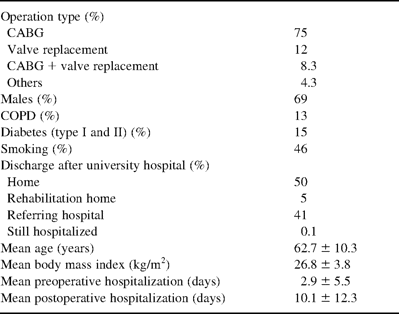
3.2 Prevalence of sternal and donor site infections
Medical records and assessments by medical attendants at the out-patient clinic and/or by infection control nurses for the surveillance of wound infections were available from all patients. The response rate of questionnaires filled in by the family physicians was 91%.
SWI were studied in all 1885 patients and DSI in 1577 patients undergoing a CABG with venous grafts (in 1573 patients the greater saphenous vein and in four patients radial arteries were used). The prevalence of SWI and DSI after cardiac surgery for the various follow-up periods is given in Table 2 . During hospitalization, 4.7% SWI and 1.5% DSI were diagnosed. Follow-up until 30 and 90 days postoperatively resulted in 2.1 and 4.3% extra SWI, respectively, and in 3.1 and 5.8% extra DSI, respectively. No DSI were diagnosed in the four CABG patients where radial arteries were used.
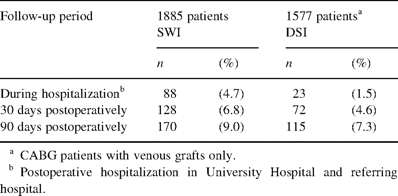
Prevalence of postoperative wound infections during different follow-up periods
The contribution of the out-patient clinic and the family physician in the diagnosis of the 90-days postoperative infection rates is given in Table 3 . Of the total numbers of SWI and DSI, 49 and 79%, respectively were diagnosed post-discharge of which 66 and 86%, respectively, were diagnosed by the family physician only. In 239 of 1577 patients (15%) a SWI and/or a DSI was diagnosed during the 90-day follow up period, being present simultaneously in only 12 (0.8%) patients.
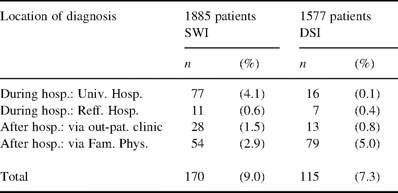
Diagnosis of postoperative sternal wound and donor site infections during and after postoperative hospitalization
Time until diagnosis in days postoperatively for total SWI (170 patients) and total DSI (115 patients) are shown in Fig. 1 . Median time until diagnosis was 8 (2–46) days for SWI and 8 (2–37) days for DSI diagnosed during hospitalization, and 26 (4–90) days for SWI and 28 (5–90) days for DSI diagnosed after discharge.
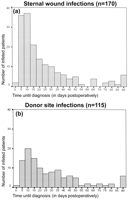
Time until diagnosis (in days postoperatively) of sternal wound infections and donor site infections in patients after cardiac surgery.
Patients with a SWI had a significantly longer operation time and extra-corporeal circulation time (255±72 and 98±58 min, P<0.05) compared with patients without a SWI (238±66 and 87±46 min).
3.3 Superficial and deep sternal wound infections
Sternal wound infections diagnosed by the family physician were not subdivided into deep and superficial. It is reasonable to assume that they were superficial because patients with a deep sternal wound usually return to the hospital or the out-patient clinic. In 25 of 1885 patients (1.3%) deep SWI and in 145 of 1885 patients (7.7%) superficial SWI were diagnosed during the 90-days postoperative follow-up. Twenty-two deep SWI were diagnosed during hospitalization and three were diagnosed via the outpatient clinic. Median time until diagnosis was comparable for both deep (14 (2–64) days) and superficial SWI (15 (2–90) days).
3.4 Wound infections and operation type
The prevalence of SWI was significantly higher in patients undergoing a CABG with use of both left (LIMA) and right interior mammary artery (RIMA), and in patients after combined surgery for CABG plus valve replacement compared with patients undergoing CABG with use of veins and/or LIMA (P<0.01). The prevalence of DSI was also higher, but not significant, in patients after combined surgery for CABG plus valve replacement compared with CABG only (Table 4) .
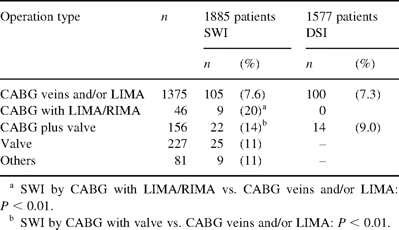
Prevalence of sternal wound and donor site infections per operation type
3.5 Hospitalization infected patients
Patients with a SWI or DSI diagnosed during hospitalization in the University Hospital had about a three times longer postoperative hospital stay than patients without a wound infection (Table 5) . For these infected patient groups, the median duration of hospitalization after diagnosis of the SWI was 17.5 (1–117) days and after diagnosis of the DSI was 7 (1–63) days. The median postoperative stay was 26 (5–126) days for patients with a deep SWI and 7 (4–147) days for patients with a superficial SWI diagnosed during hospitalization (P<0.001).
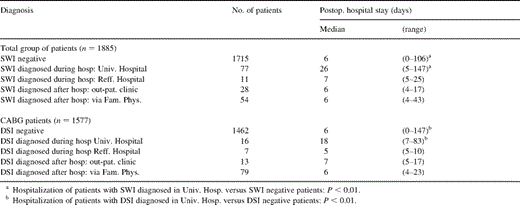
Postoperative hospital stay of patients with and without wound infection
3.6 Deceased patients
Peroperatively, 30 and 90 days postoperatively, four (0.2%), 49 (2.6%) and 65 patients (3.4%), respectively, died. The deceased patients (n=65) developed high numbers of infections: SWI (15%), DSI (4.6%), blood stream infections (32%), infections of infusion lines (31%), respiratory tract infections (52%), urinary tract infections (42%) and endocarditis (1.5%).
Autopsy was performed in 39 of 65 patients. Causes of death were due to cardiac failure in 25 patients, cardiovascular surgical complications in eleven patients (such as surgical bleeding, posterior wall rupture, ongoing dissection or ventricular septal re-rupture), gastrointestinal complications in eight patients, pulmonary or neurological complications in seven patients, multiple organ failure in two patients, other and unknown causes in seven and three patients, respectively. In nine patients infectious complications (three mediastinitis, one pneumonia and four sepsis) were the predominant cause of death.
3.7 Culture results
Sternal wound cultures were taken on clinical indication of the treating physician and were not available for all infected patients. In total, 162 culture-positive specimens from surgical wounds, originating from 117 patients were available. The ten most frequent isolated species from sternal wound infections were: Staphylococcusaureus (26%), Pseudomonasaeruginosa (10%), Enterococcusfaecalis (9.5%), Staphylococcusepidermidis (8.0%), Escherichiacoli (7.7%), Proteusmirabilis (6.9%), Enterobactercloacae (5.4%), Bacteroidesfragilis (2.3%), other coagulase-negative Staphylococci (2.3%), and Morganelamorganii (1.7%). Polymicrobial cultures were found in 52 of 162 specimens.
4 Discussion
In the present study, after cardiac surgery 9.0% of the patients developed a sternal wound infection (1.3% deep and 7.7% superficial) and 7.3% of patients developed a donor site infection during the 90-days postoperative follow-up period. The prevalence of deep SWI is in line with findings by others reporting 0.1–2.9% deep SWI [1–4,11–13]. The prevalence of total wound infections (i.e. 15%) are in the higher range, as in the literature prevalences of 3–12.8% have been reported [1,3,7,8]. Because studies differ in their follow-up of postoperative wound infections, a proper comparison of infection rates is difficult. Most studies only follow their patients during hospitalization [1,7] or 4–6 weeks postoperatively [3,8], while some do not mention their follow-up period at all. A pilot-study in the University Hospital Maastricht has shown that a substantial number of surgical wound infections were diagnosed after 30 days postoperatively and/or post-discharge. A uniform definition of post-surgical wound infections is important for inter-hospital comparisons [14] and surveillance and feedback of wound infections has been shown to reduce the prevalence of infections and to be cost-effective [15].
In this study, both 30- and 90-day follow-up resulted in additional diagnoses of wound infections compared with surveillance during hospitalization only. A quarter of SWI and more than a third of DSI were diagnosed between 30 and 90 days after cardiac surgery, demonstrating the importance of a prolonged surveillance and a uniform definition of postoperative wound infections, especially as nowadays hospital discharge occurs as early as possible [6]. During the 90-day postoperative follow-up, almost 50% of SWI and 80% of DSI were diagnosed post-discharge. These results are in line with others [16–18]. In our study, the majority of the wound infections presenting post-discharge were diagnosed by the family physician only. Regular visits by an infection control nurse, both in the hospital and at home, is the most effective way for monitoring wound infections. However, this was practically impossible in this large population from all over the province Limburg.
Culliford et al. [19] describe an ‘early onset’ group (presenting within the first month postoperatively) and a ‘late onset’ group of sternal wound infections after cardiac surgery (presenting after the first month postoperatively) and found a better prognosis for the early compared with the late group of wound infections. This supports the importance of post-discharge surveillance especially as nowadays hospital discharge occurs as early as possible [6].
In the literature the mean time of diagnosis of deep SWI after cardiac surgery ranges from 4 to 30 days postoperatively [4,20–22]. In this study, SWI were diagnosed with a median of 8 days when diagnosed during hospitalization and 26 days when diagnosed after discharge. This relatively long time-interval suggests that not only operation-related risk factors but also factors in the postoperative period such as wound management [14,21] and the resorption of sutures may play a role.
Hospital stay of patients with a SWI diagnosed during hospitalization in the University Hospital was significantly longer compared with patients without a wound infection. The finding that these infected patients had a median hospitalization of 17.5 days after the diagnosis of SWI supports the hypothesis that the wound infection may contribute to the increased hospitalization. The longer hospitalization of infected patients was due to patients with deep SWI. This observation is in line with others [9].
Paying special attention to donor site infections, 7.3% DSI were diagnosed in this study. Only a few studies have reported on DSI separately. Prevalences range from 1.1 to 6.8% with varying follow-up periods [1,5,6,23]. Accurate data have been reported by Bellchambers et al. [24] who followed the patients until 3 months postoperatively. They observed 13% DSI of which 76% was diagnosed after discharge. This last finding is in line with our observation. El Oakley et al. [3] found DSI to be a significant risk factor for the development of mediastinitis. In our study, a significantly longer hospitalization was observed for patients with DSI site infections diagnosed in the University Hospital compared with patients without a wound infection.
Antibiotic prophylaxis for only 24 h seems to be effective in preventing infections after cardiac surgery [25]. Cefazolin prophylaxis used in the present study, is found to be effective against the most frequently isolated micro-organisms, i.e. the staphylococci. Pseudomonasaeruginosa was isolated with a mean of 30 days postoperatively and are therefore more likely to result from contamination in the postoperative period than in the peroperative period.
In conclusion, in patients after cardiac surgery, attention should be paid to both sternal wound infections and donor site infections. Post-discharge surveillance up to 90 days postoperatively is essential for a reliable assessment of surgical wound infections. The family physician plays a major role in the documentation of post-discharge diagnosed wound infections.




